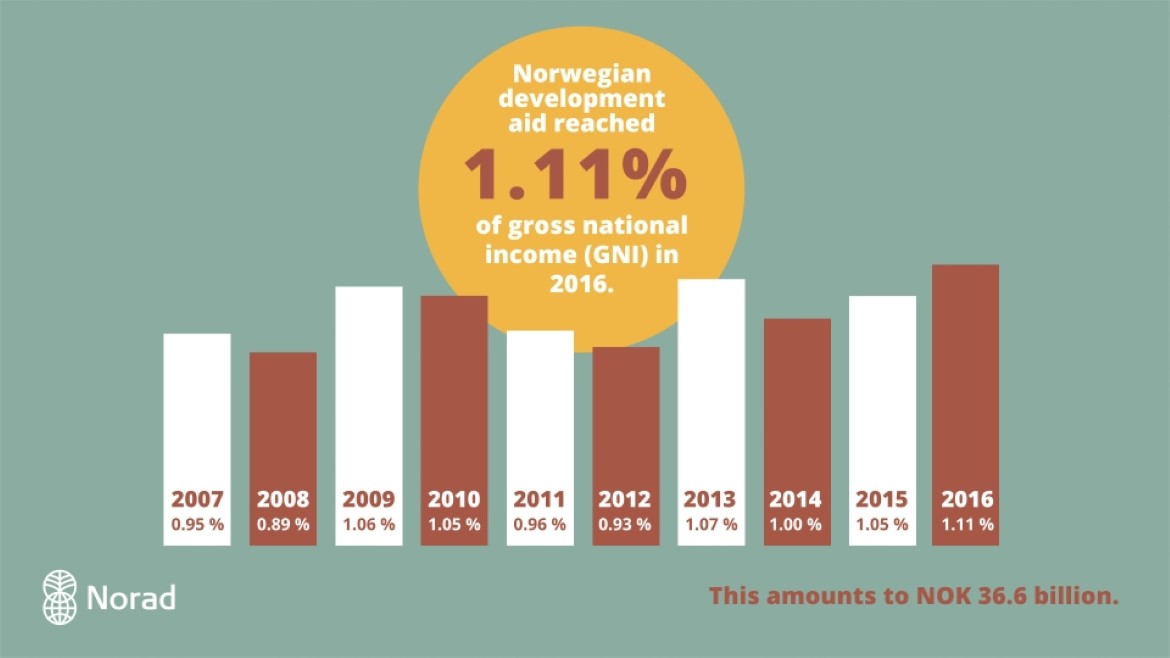
Record-high development assistance
Updates figures
December 2017: Norway’s development assistance for 2016 has been adjusted since this article was published in April 2017. Thus, some of the figures deviate from updated figures in the Norad statistics portal.
Total development assistance for 2016 was NOK 36.8 billion. Norwegian assistance amounted to 1.12 per cent of Norway's gross national income (GNI).
‘Norwegian development assistance continues to grow, and makes an important contribution to global development. The long-term crisis in Syria is significantly reflected in Norwegian development aid statistics,’ says Norad director Jon Lomøy.
The crisis in Syria also puts Lebanon and Iraq into the top-ten list of countries that received the most Norwegian development aid in 2016. Aid to the Middle East has been increasing for a number of years, and almost doubled from 2014 to 2016, reaching NOK 3.3 billion in 2016, of which 1.9 billion was in the form of humanitarian assistance.
The figures have been retrieved from Norad’s statistics portal, on which the latest official figures are now available. Norwegian development aid statistics are in accordance with OECD’s Statistical Reporting Directives.
High refugee costs
In 2016, altogether NOK 6.7 billion of the aid went to refugees in Norway, corresponding to 18.4 per cent of total aid.
‘It is worth noting that almost one-fifth of the aid was used to cover costs in Norway resulting from the large influx of refugees,’ says Lomøy.
The portion of the development aid budget allocated to refugee costs in Norway increased significantly in 2016, up from NOK 3.7 billion the previous year. The reason is the high number of refugees who arrived in Norway late in 2015. OECD’s Statistical Reporting Directives make it possible to charge parts of the refugee costs as development aid in the first 12 months after the refugees arrive in the country.
A total of NOK 7.4 billion in development aid was budgeted for refugee costs in 2016. The statistics show that the final figure was lower than planned. Aid costs for refugees in Norway are administered by the Ministry of Justice and Public Security, the Ministry of Children and Equality and, to a lesser extent, the Ministry of Education and Research.
Humanitarian assistance
The crisis in Syria is reflected not only in the geographic distribution of the development assistance, but also thematically.
Recent years have seen an increase in support to humanitarian assistance. In 2016, humanitarian assistance amounted to NOK 3.7 billion, half of which went to the Middle East. Norway also provided considerable humanitarian assistance to South Sudan (NOK 297 million) and Afghanistan (NOK 227 million).
In addition to development aid that is classified as humanitarian assistance in the statistics, other aid was also granted to long-term efforts in humanitarian situations, such as aid to education in Syria and Lebanon, classified as aid to education in the statistics, and core funding to UN organizations such as the Office for the Coordination of Humanitarian Affairs (OCHA) and the Central Emergency Response Fund (CERF).
Less for local organizations
Humanitarian assistance is mainly channelled through Norwegian civil society organizations and multilateral organizations such as the UN Refugee Agency (UNHCR) and the World Food Programme (WFP).
Support to local civil society organizations fell by NOK 273 million. This reduces the proportion of civil society support to these types of organizations from 13 per cent in 2015 to 9 per cent in 2016.
Education still a priority area
The Norwegian Government continues to prioritize education. From 2015 to 2016, support to education rose by almost NOK 700 million to NOK 3.2 billion. A total of NOK 2.2 billion went to basic education, corresponding to 69 per cent of the aid to education.
A little less than 50 per cent of the support went to global projects and joint programmes, for example through multilateral organizations such as UNICEF and the Global Partnership for Education (GPE). UNICEF was by far the largest recipient of aid to education in 2016, and received just over NOK 1 billion earmarked for educational purposes.
Of the aid to education distributed by country and region, Africa with 45 per cent was the region that received the most. This corresponded to NOK 739 million. Aid to education increased in almost all regions, with support to the Middle East representing the greatest increase.
The Norwegian Government places a high priority on education in conflict situations. This is reflected in the figures, with Lebanon and Syria having received the most with NOK 183 million and NOK 139 million each respectively.
‘The world cannot afford to lose a generation of children. Education is essential, even during crises and conflicts. Norway is therefore working innovatively in the field of education, for example through the development of computer learning games for Syrian children,’ says Lomøy.
Less for energy and the environment
Development assistance for energy and the environment fell from NOK 4.2 billion in 2015 to NOK 3.6 billion in 2016, a decrease of 14 per cent. The distribution of this reduction was close to NOK 270 million for the energy sectors and just under NOK 330 billion for environmental protection. The reduction in the area of environmental protection is largely the result of a lower disbursement to the Government of Norway’s International Climate and Forest Initiative in 2016.

